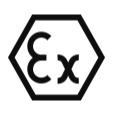Explosion proof manual call points vs standard MCPs
6 September 2024
Standard manual call points should not be used in potentially explosive atmospheres. Why? Simply because they could cause an explosion and fire, which is exactly what they are there to warn people of in the first place. We explain what operators and installers should be looking for when selecting manual call points for hazardous areas.
What is a Manual Call Point?
Manual call points (MCP) are typically used to activate an alarm in the event of a fire or explosion.
The wall-mounted red boxes saying “Press Here” or “Break Glass” are positioned along corridors and next to exit routes in all types of businesses and organisations and are manually triggered in the event of a fire or explosion. They are an essential component in a fire safety system and can also be integrated with other fire safety equipment, such as smoke detectors and sprinkler systems.
In normal operations the manual call points should be mounted at a height of approximately 1.2 metres (4.5 feet) to ensure visibility and accessibility in the event of a fire or explosion. In a building or workplace, there should be sufficient MCP units installed within a reasonable distance to workstations and near to specific hazards so they can be easily located in an emergency.
Don’t forget that MCPs are crucial for raising an alarm during a fire or explosion emergency in all types of industrial operations, schools, public buildings, retail and many other buildings. However, the need for such devices on high-risk sites, such as in the oil and gas supply chain, petrochemical, pharmaceutical, chemical, logistics or other hazardous manufacturing operations is even more acute where flammable gases, liquids (vapours), or dust particles are actively handled or stored.
What is an Explosion Proof Manual Call Point?
Firstly, any operation working with flammable material will need to assess and classify their areas of operation according to the materials handled and risk. In Europe and many parts of the world this involves classifying areas in line with the ATEX Directives as Zone 1 or Zone 2 if flammable gas or vapour is present or Zone 21 or Zone 22 if there are powder or dust hazards.
Most hazardous area operations have already classified their areas which means that ANY equipment or machinery in those areas have to meet certain safety specifications, typically ATEX or IECEx (an international system that certifies equipment for use in explosive environments).
Lights, beacons, switches, forklifts and more need to meet these safety standards, manual call points included!
Why should manual call points be ATEX Certified in hazardous areas?
Most electrical or mechanical equipment, even MCPs, could potentially act as an ignition source from heat, static, sparks and more unless it has suitable explosion protection. This means they could cause an explosion if a flammable gas, vapour or powder is suddenly present.
The manual call point is also available in green and is commonly used for emergency door release.
To be safe, these devices must be designed and built so that they cannot be the source of an ignition while still performing their intended use, such as triggering a fire alarm.
Legally, the explosion proof design and build must conform with specific European (ATEX) and international standards (IECEx) so that it can be used in hazardous (EX) areas such as in refineries, petrochemical plants, and pharmaceutical facilities with highly flammable gas, vapours, dusts or powders. ATEX / IECEx certification labels are clearly shown on each Ex MCP.
Explosion proof MCPs should be built to rigorous standards and enclosed in robust, sealed casings to prevent any sparks or flames that may escape from igniting the surrounding hazardous environment.
Explosion proof, sometimes referred to as flameproof manual call points are typically made from materials designed to withstand harsh conditions, such as corrosion-resistant metals or high-impact plastics and have high Ingress Protection (IP) ratings to help prevent infiltration of dust or water and ensure they do not become a source of ignition. This is a very different design requirement when compared to standard office manual call points made from lightweight plastics.
In hazardous areas, additional care should also be taken to mount MCPs in safe locations where they will not be exposed to conditions that could compromise their integrity or function. Afterall, reliability is critical in high-risk operations that rely on process safety.
Explosion proof Manual Call Points from Ex-tech Signalling are only built for hazardous areas
As part of the Pioneer Safety Group, our focus is on explosion protection safety and how our signalling products can be used safely in hazardous areas.
That means that not only do our manual call points comply with ATEX and IECEx for potentially explosive atmospheres, but they are also robust, reliable and designed for optimum performance in tough and harsh hazardous area operations.
Designed and built in the UK (United Kingdom) using quality materials, the “Break Glass” or push button flameproof manual call points can tolerate corrosive conditions and are compatible with Programmable Logic Controller (PLC), Emergency Shutdown (ESD), and Distributed Control (DCS) systems. All manual call points are available with SIL2 certification.
The Ex-tech Signalling CP 125 ATEX / IECEx manual call point is encased in stainless steel and covered in ultraviolet resistant paint for extra protection and comes with a hammer and securing chain.
The CP 135 Ex MCP (seen above) and 150 explosion proof manual call points are moulded in glass-reinforced polyester (GRP) then coated in UV resistant paint and have a built-in test function. To avoid accidental activation, all call points are available with optional lift flaps. All three ATEX / IECEx manual call point units can be customised with optional extras, such as visualisation functions and line detection.
Used in conjunction with a fire alarm system, all explosion proof MCPs from Ex-tech Signalling will help warn personnel across a site of potential dangers coming from a hazardous area and allow them to take remedial action in emergency situations.
Want to know more? Talk to Ex-tech Signalling, UK manufacturers of explosion proof manual call points.


















